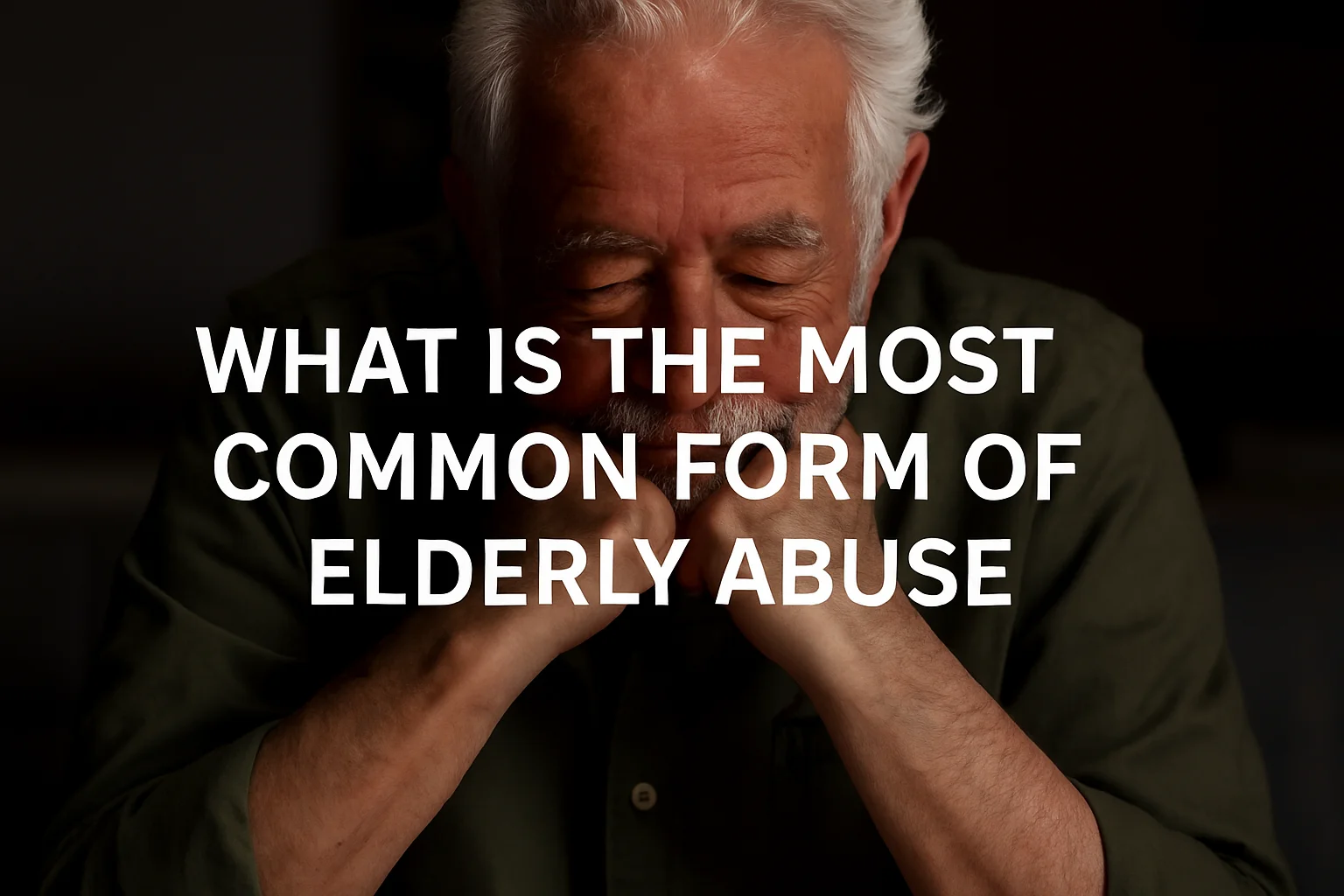Understanding what is the most common form of elderly abuse helps families recognize the warning signs of neglect in care settings. In California, elder neglect is frequently linked to missed medications, delayed medical attention, and lack of proper supervision. These patterns often result in preventable injuries, emotional distress, and serious health complications. Recognizing the signs early and taking timely action can protect vulnerable seniors and ensure their safety.
Table of Contents
Understanding Elder Abuse in Care Settings
What Is the Most Common Form of Elderly Abuse is a question that highlights the ongoing vulnerability of older adults across California. Elder abuse can occur in any setting where care is provided, including nursing homes, assisted living facilities, and private residences. It refers to any act that causes physical, emotional, or financial harm to an elderly. Especially when that act is committed by someone responsible for their care.
In many care settings, neglect is one of the most frequently reported forms of abuse. This includes failure to provide proper hygiene, medication, supervision, or medical attention. Inadequate staffing, poor training, or indifference from caregivers often lead to dangerous delays in care. For residents with limited mobility or cognitive decline, neglect can result in severe injuries or even wrongful death.
Physical abuse, such as forceful handling, hitting, or restraint, is also reported in long-term care facilities. These incidents often go unreported until injuries become obvious. Emotional abuse may appear in the form of verbal threats, humiliation, or intentional isolation, causing psychological trauma over time.
The most common form of elderly abuse is not always visible. Financial exploitation, such as unauthorized access to bank accounts or manipulation of legal documents, is widespread and often uncovered too late. Understanding how abuse happens in care environments is the first step toward prevention. Families, care staff, and legal advocates all play a role in protecting the safety and dignity of aging individuals.
Patterns Observed in Real California Elder Abuse Cases
What is the most common form of elderly abuse is clearly revealed when reviewing legal settlements involving neglect. At Moran Law, we dedicated to elder abuse litigation, patterns of neglect stand out across numerous cases in nursing homes and assisted living facilities.
In one case, a resident with dementia was not monitored for fall risk and suffered a hip fracture due to the facility’s failure to implement any fall prevention measures. Another case involved a stroke survivor who was left alone on the toilet without assistance. The fall resulted in a brain bleed and led to death.
Multiple cases show delayed medical responses. In one, a resident displayed symptoms of a stroke for three days before a physician was notified. This delay prevented the use of life-saving stroke medication. In another case, a resident’s unresponsive condition was ignored for two days, and even after the physician ordered emergency care, staff waited another two hours before calling 911. The result was death from sepsis due to pneumonia.
Neglect also includes failure to reposition bedridden patients. One resident developed severe pressure ulcers and fatal infections after staff failed to turn her regularly. In another case, a facility delayed a wound consult for over two weeks, leading to stage four ulcers.
Each of these cases reflects a common thread: neglect as the most common form of elderly abuse. These patterns show how a lack of supervision, delayed treatment, or ignoring basic care standards can cause irreversible harm. By identifying these failures early, families can intervene before similar outcomes occur.
Why Neglect Is the Most Common Form of Elder Abuse
What is the most common form of elderly abuse is a question often asked by concerned families seeking answers about the safety of their loved ones. Among the different types of mistreatment reported in long term care facilities, neglect remains the most frequently identified form of abuse, especially in nursing homes and assisted living settings across California.
Neglect involves the failure to provide essential care, either through inaction or systemic failure. It can be subtle at first, but its consequences are often severe. A consistent pattern found in California elder abuse cases shows residents left without supervision despite being fall risks. In one instance handled by Moran Law, a resident was left unattended in a wheelchair, attempted to transfer to bed alone, and sustained a fatal brain injury after falling. In another, a diabetic patient went into a coma because the facility failed to monitor and administer critical insulin doses.
Missed medications are another recurring sign of neglect. Facilities have delayed or failed entirely to administer life-saving prescriptions, leading to preventable deaths. One resident suffered respiratory failure after not receiving BiPAP therapy as ordered. Others were not given antibiotics or stroke medication within the proper window, resulting in permanent harm or death.
Ignored fall precautions also appear in many cases. Some facilities failed to install bedrails, while others removed them without consent, causing residents to roll out of bed and suffer head injuries or fractures. Delays in emergency response make these situations worse. Several cases involved facilities waiting hours or even days before calling 911, even when clear signs of stroke, infection, or unresponsiveness were present.
These are not isolated events but part of a broader pattern that reflects insufficient staffing, poor training, and failure to follow care protocols. Neglect continues to be the most reported form of elder abuse because it can occur quietly and frequently, with devastating consequences when overlooked.
Common Signs of Elder Neglect Families Should Watch For
Neglect is often overlooked but is one of the clearest answers to the question: what is the most common form of elderly abuse. In care settings across California, families must stay vigilant for subtle and visible signs of neglect. When basic needs go unmet, the consequences can be devastating.
One key red flag is poor personal hygiene. If a resident is consistently unbathed, wearing soiled clothes, or left in the same position for extended periods, it may point to a lack of staff attention. Similarly, untreated wounds, bedsores, or unexplained bruises can be signs that medical needs are being ignored. Malnutrition and dehydration are also serious indicators. Dry lips, sunken eyes, and weight loss often result from neglecting food and fluid intake. If caregivers cannot explain these changes or dismiss them without proper evaluation, further investigation is warranted.
Environmental cues also matter. A cluttered or dirty living space, strong odors, or broken safety equipment show that a facility may be failing to maintain safe and clean conditions. Emotional changes are equally important. If a loved one appears withdrawn, anxious, or fearful around staff, this shift in behavior could signal ongoing neglect or mistreatment.
Sudden health declines that are not medically explained may point to missed medications or untreated conditions. When caregivers fail to respond promptly to pain, illness, or behavioral changes, the outcome can be life threatening. Family members in California should not hesitate to speak up when something feels wrong. Patterns of neglect often start small but escalate quickly if left unaddressed. Early recognition can protect vulnerable residents from serious harm.
Consequences of Elder Neglect
Understanding the consequences of elder neglect is critical for families, caregivers, and legal advocates. When asking what is the most common form of elderly abuse, the answer often leads to neglect, and its impacts are far-reaching. From physical harm to emotional trauma, the damage caused by neglect can be severe and irreversible.
Physically, neglect leads to preventable injuries and illnesses. Missed medications, untreated wounds, and lack of supervision often result in rapid health deterioration. For instance, Moran Law has represented families where residents suffered fatal brain bleeds after falls that could have been prevented with proper monitoring. In other cases, failure to turn and reposition immobile residents resulted in painful stage 4 pressure ulcers, sepsis, and death.
Neglect also affects emotional and psychological wellbeing. Seniors who feel abandoned or ignored may become withdrawn, depressed, or anxious. The lack of human interaction, delays in receiving care, and repeated unmet needs erode trust and dignity. These emotional injuries are often overlooked but can leave lasting scars.
The legal consequences for facilities and caregivers are equally serious. In California, elder neglect is not just a civil violation. It can also lead to criminal charges when there is a willful failure to provide necessary care. Families have turned to Moran Law after facilities ignored critical health issues, resulting in hospitalization, permanent disability, or death. The firm’s case history includes multimillion-dollar settlements against nursing homes and assisted living centers where systemic neglect went unchecked.
Neglect is not simply a mistake or oversight. It is a breach of duty that places vulnerable people at serious risk. The law holds care providers accountable, and legal action sends a clear message that failure to protect elderly residents has real and serious consequences.
Contact Moran Law for Elder Neglect Cases in California
Understanding what is the most common form of elderly abuse is the first step toward protecting your loved ones. In many California care settings, neglect stands out as the leading cause of serious harm, from untreated medical conditions to fatal falls and delayed emergency response.
Moran Law brings over 25 years of focused experience in elder abuse litigation. The firm has handled some of the most complex neglect cases across the state, including a $4 million settlement where an assisted living facility failed to supervise a resident with dementia, resulting in a fatal head injury.
Families turn to Moran Law for legal support because they understand the system, know how to build strong cases, and fight to hold negligent facilities accountable. If you suspect elder neglect in a nursing home or assisted living environment, contacting a skilled legal team can make all the difference. Reach out to Moran Law today for a confidential consultation and learn how experienced elder abuse attorneys can help protect your family.


